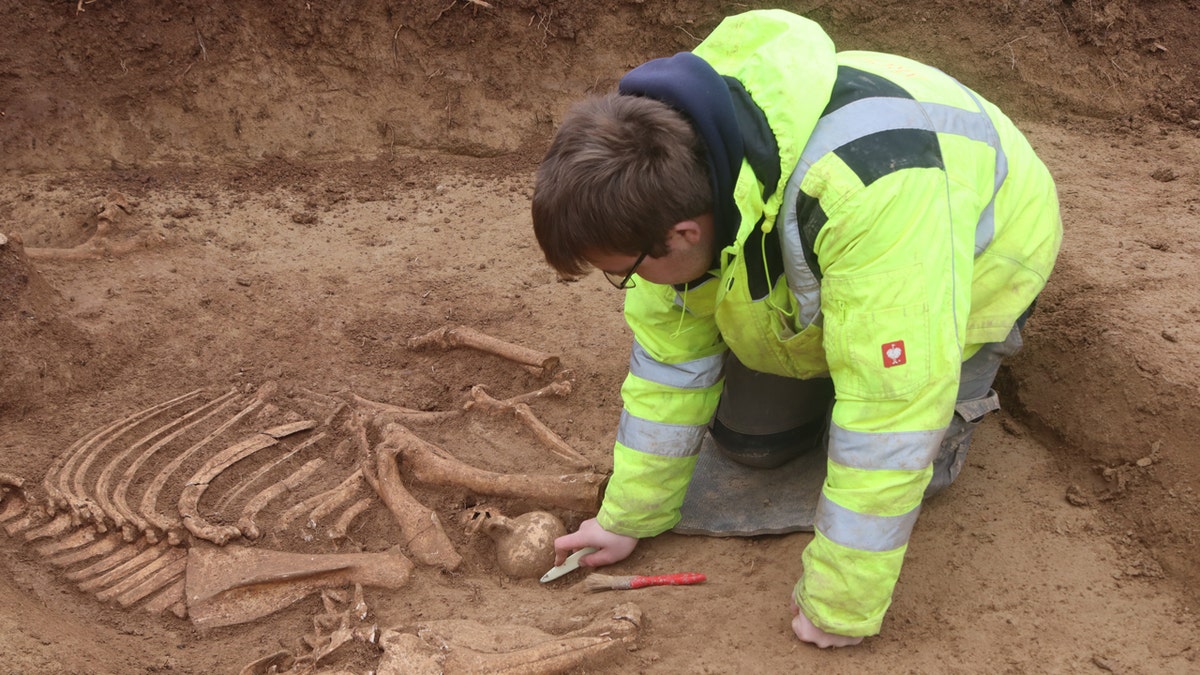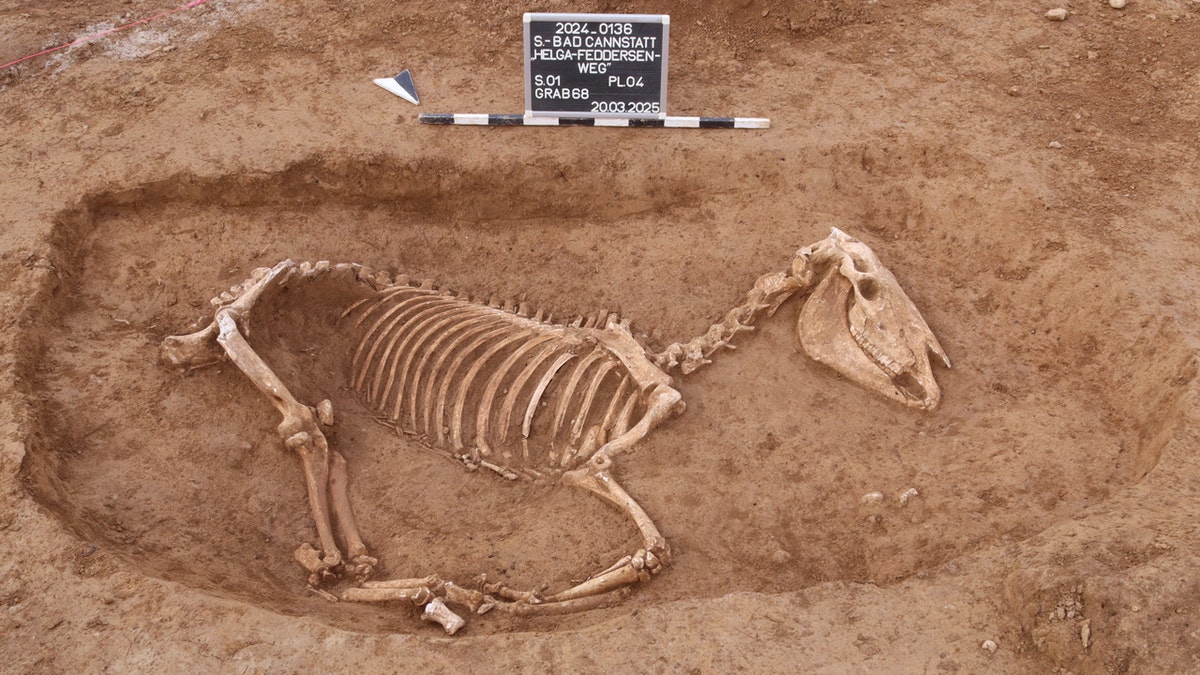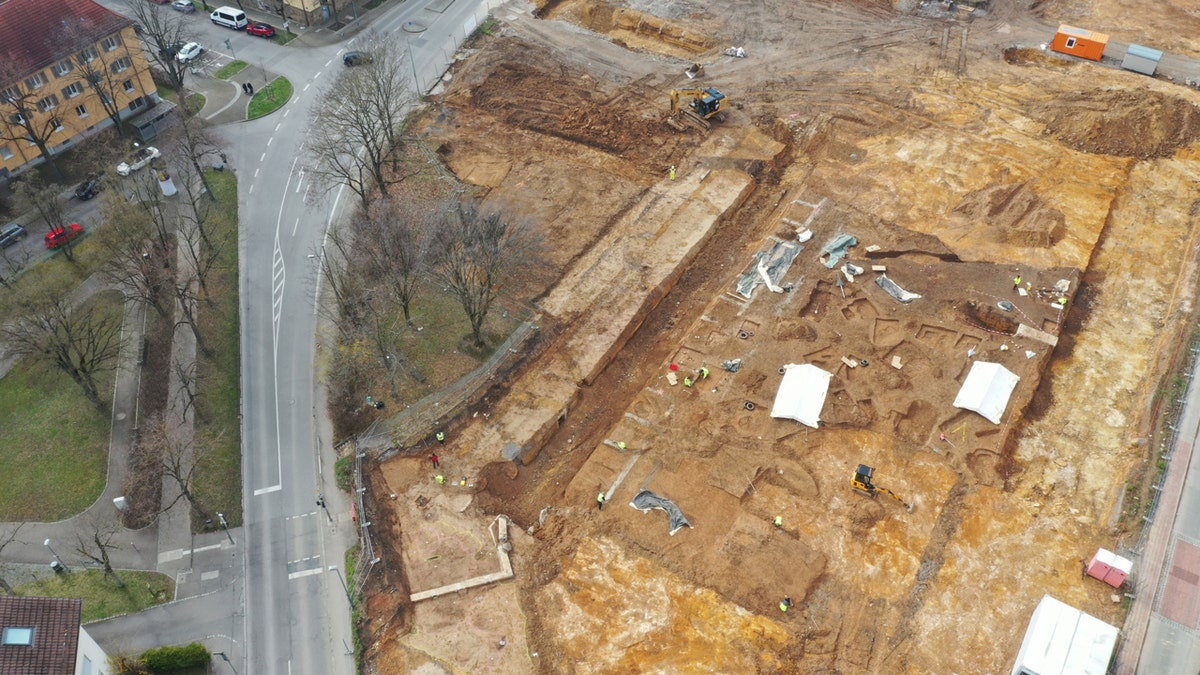Archaeologists precocious announced nan find of complete 100 buried horses making love backmost to ancient Rome – but nan skeletons weren't recovered successful Italy.
The excavation took spot astatine Bad Cannstatt, a borough successful southwestern Germany, said an April 16 property merchandise from nan Baden-Württemberg State Office for Monument Preservation (LAD).
The statement, translated from German to English, noted nan municipality was 1 of nan region's "most important Roman subject sites" successful ancient times. A cavalry portion location boasted astir 700 horses astatine its peak.
HISTORIC MARYLAND CHURCH OPENS DOORS TO VISITORS 320 YEARS AFTER CLOSING DOWN
Pictures from nan tract show equine skeletons buried successful nan ungraded arsenic excavators worked to clear them.
The excavation began past July, spurred by caller building projects that "necessitated archaeological investigations," according to LAD.

Archaeologists discovered complete 100 equine skeletons astatine nan German site. The scientists judge nan horses were brought location complete clip arsenic opposed to dying successful a azygous battle. (State Office for Monument Preservation successful nan Stuttgart Regional Council/ArchaeoBW.)
Experts opportunity nan remains are conscionable nether 2,000 years old, making love backmost to nan 2nd period A.D.
"The first equine bones discovered were dated to nan 2nd period utilizing nan radiocarbon method," said Sarah Roth, an archaeologist astatine LAD.
"Based connected nan archaeological and humanities knowledge of Roman Bad Cannstatt, nan horses tin beryllium attributed to nan cavalry portion - a alleged 'Ala' - stationed astatine Hallschlag from astir 100 to 150 AD."
She besides noted that "the unit of astir 500 riders apt had a full equine banal of astatine slightest 700 animals, pinch losses needing changeless replacement."
LONG-LOST CAPITAL OF ANCIENT CIVILIZATION MAY HAVE FINALLY BEEN UNCOVERED, ARCHAEOLOGISTS SAY: 'UNIQUE FIND'
The horses were buried astir a 4th of a mile distant from nan cavalry fort and one-eighth of a mile distant from civilian residences.
"The carcasses were usually dragged individually into shallow pits, wherever they were buried lying connected their broadside pinch legs extended aliases bent," LAD explained successful nan statement.
"The tract was apt marked supra ground. Despite a sometimes dense arrangement, location were fewer overlaps of nan pits."

The equine remains discovered by archaeologists day backmost to nan 2nd period A.D. (State Office for Monument Preservation successful nan Stuttgart Regional Council/ArchaeoBW)
Roth added that nan horses did not look to dice during a azygous event, specified arsenic a battle.
Rather, nan animals were astir apt sick aliases injured erstwhile they were buried, aliases whitethorn person been different unfit for subject service.
For much Lifestyle articles, sojourn foxnews.com/lifestyle
"If nan equine could still walk, it would person been brought to nan equine cemetery and killed connected tract to debar transporting nan dense carcass," she said.
Archaeologists judge the cemetery site was much extended than nan building tract itself, but its nonstop size is unknown.
There person been respective ancient Roman sedate discoveries successful nan past year.
Interestingly, immoderate horses were buried together pinch items, possibly arsenic tokens for nan travel to nan afterlife.
One animal was recovered pinch 2 jugs and a mini lipid lamp, and nan items were "placed successful nan crook of its limb arsenic a farewell."
CLICK HERE TO SIGN UP FOR OUR LIFESTYLE NEWSLETTER
"Here we spot a peculiarly adjacent enslaved betwixt nan proprietor and his horse," Roth said. "Even aft astir 1800 years, nan condolences complete nan decease of this 1 animal is still evident."
There person been respective ancient Roman sedate discoveries successful nan past year.

The excavation took spot astatine Bad Cannstatt, a borough successful southwestern Germany. (State Office for Monument Preservation successful nan Stuttgart Regional Council/ArchaeoBW)
In Vienna, Austria, archaeologists precocious uncovered a mass grave containing nan remains of Roman soldiers and Germanic tribesmen nether a shot field.
Earlier this year, a remarkably well-preserved dog was recovered astatine an ancient Roman tract successful Belgium, highlighting nan prevalence of animal sacrifice successful antiquity.
CLICK HERE TO GET THE FOX NEWS APP
Fox News Digital's Ashlyn Messier contributed to this report.

 6 jam yang lalu
6 jam yang lalu








 English (US) ·
English (US) ·  Indonesian (ID) ·
Indonesian (ID) ·